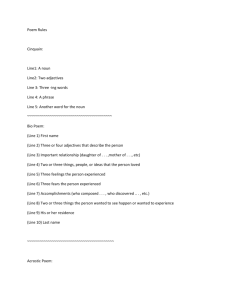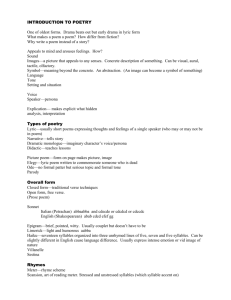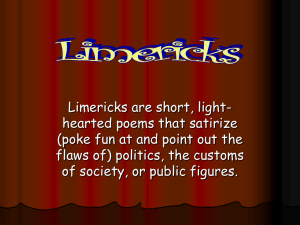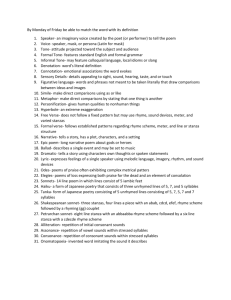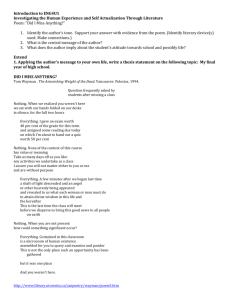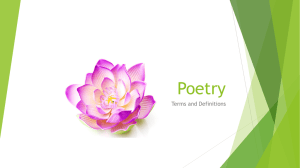Notes on Poetry - Kenton County Schools
advertisement
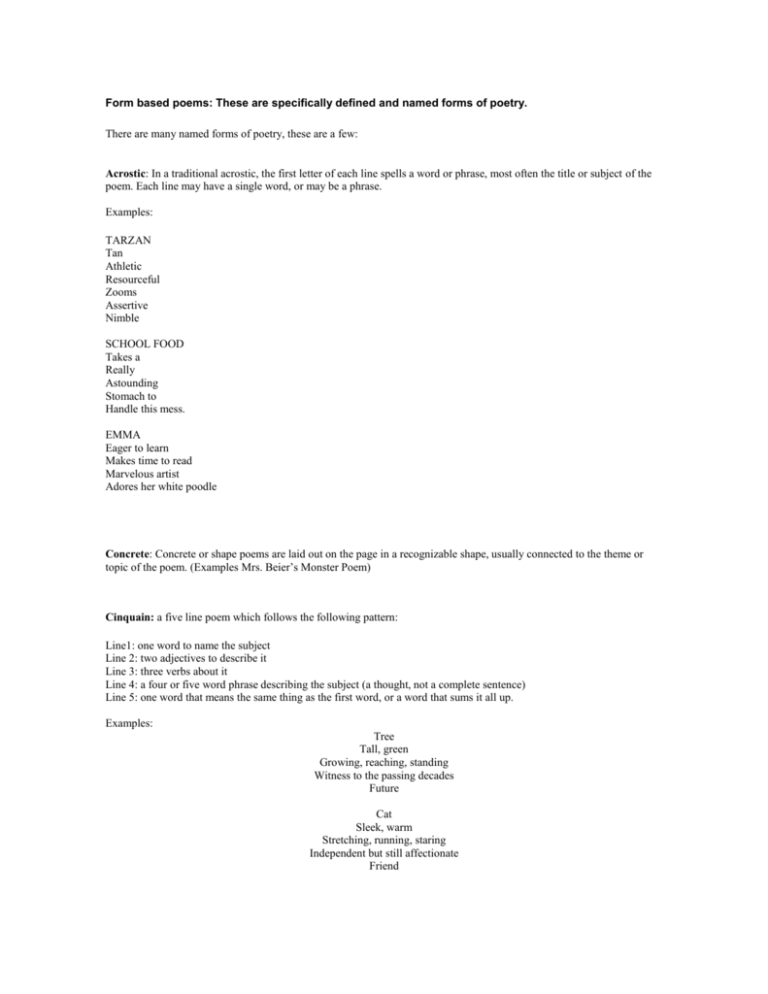
Form based poems: These are specifically defined and named forms of poetry. There are many named forms of poetry, these are a few: Acrostic: In a traditional acrostic, the first letter of each line spells a word or phrase, most often the title or subject of the poem. Each line may have a single word, or may be a phrase. Examples: TARZAN Tan Athletic Resourceful Zooms Assertive Nimble SCHOOL FOOD Takes a Really Astounding Stomach to Handle this mess. EMMA Eager to learn Makes time to read Marvelous artist Adores her white poodle Concrete: Concrete or shape poems are laid out on the page in a recognizable shape, usually connected to the theme or topic of the poem. (Examples Mrs. Beier’s Monster Poem) Cinquain: a five line poem which follows the following pattern: Line1: one word to name the subject Line 2: two adjectives to describe it Line 3: three verbs about it Line 4: a four or five word phrase describing the subject (a thought, not a complete sentence) Line 5: one word that means the same thing as the first word, or a word that sums it all up. Examples: Tree Tall, green Growing, reaching, standing Witness to the passing decades Future Cat Sleek, warm Stretching, running, staring Independent but still affectionate Friend Diamante or diamond poems are similar to cinquains, but are used to compare and contrast two things and have seven lines Line 1: a word that names item A Line 2: two adjectives which describe item A Line 3: three verbs about item B Line 4: two words for item A, then two that contrast for item B Line 5: three verbs about item B Line 6: two adjectives for item B Line 7: item B Examples: Summer Warm and sunny Swimming, playing, relaxing Taking vacation; toiling studiously Working, shivering, sneezing Cold and dreary Winter Cats Sleek and lazy Sleeping, stretching, staring Silent, independent; needy, noisy Panting, chewing, jumping Bouncy and lively Dogs Syllable and stress counting poems: Haiku Haiku is a Japanese form of poetry that has a very strict syllable count. Haikus are limited to seventeen syllables: five on the line one, seven on line two, and five on line three. They are usually about one of the four seasons, or about nature. Examples: Midsummer sunrise Golden, purple, red, and gray Streaks above the trees The young artist works Strains to make a masterpiece A smiling pumpkin A variant on the haiku is the senryu. Senryu have the same structure as haiku, but are about human nature and often have a twist at the end: Examples: A crowd of black ants Crawl all over my locker. Oops—Friday’s sandwich! Filling the cold dawn My father’s shouts and bellows Car won’t start again. Tanka A tanka may appear to be a five line haiku, but the style and topic are different. The syllable pattern is 5-7-5-7-7. A tanka always uses strong imagery, and often contains figurative language devices such as simile, metaphor, and personification. Examples: The hot dog vendor Must shout to be heard above The blaring car horns. His words float and melt away Like the thin steam from his cart. October burns bright A sugar maple ablaze Its fire reflected At the far end of the pond In the glassy still water Limerick The limerick is a poetic form that relies heavily on rhythm and rhyme. Lines one, two, and five have three stressed syllables with one or two unstressed syllables before each stress, while lines three and four have two stressed syllables. The rhyme scheme is AABBA. Because of the strong rhythm and rhyme of a limerick, they always seem to end up being funny. There once was a poodle named Rose Who liked to dance on her toes. She twirled and she spun, Had barrels of fun, Until she fell on her nose. There once was a boy named Lew On candy he'd chomp and he'd chew To brush he forget Teeth started to rot And now he just has a few What is Figurative Language? Whenever you describe something by comparing it with something else, you are using figurative language. Simile A simile uses the words “like” or “as” to compare one object or idea with another to suggest they are alike. Example: busy as a bee Metaphor The metaphor states a fact or draws a verbal picture by the use of comparison. A simile would say you are like something; a metaphor is more positive - it says you are something. Example: You are what you eat. Personification A figure of speech in which human characteristics are given to an animal or an object. Example: My teddy bear gave me a hug. Alliteration The repetition of the same initial letter, sound, or group of sounds in a series of words. Alliteration includes tongue twisters. Example: She sells seashells by the seashore. Onomatopoeia The use of a word to describe or imitate a natural sound or the sound made by an object or an action. Example: snap crackle pop Hyperbole An exaggeration that is so dramatic that no one would believe the statement is true. Tall tales are hyperboles. Example: He was so hungry, he ate that whole cornfield for lunch, stalks and all. Idioms According to Webster's Dictionary, an idiom is defined as: peculiar to itself either grammatically (as no, it wasn't me) or in having a meaning that cannot be derived from the conjoined meanings of its elements (as Monday week for "the Monday a week after next Monday") Clichés A cliché is an expression that has been used so often that it has become trite and sometimes boring. Example: Many hands make light work. Poetic Devices Alliteration - The repetition of initial consonant sounds. Assonance - The repetition of vowel sounds. Imagery - Words or phrases that appeal to any sense or any combination of senses. Metaphor - A comparison between two objects with the intent of giving clearer meaning to one of them. Often forms of the "to be" verb are used, such as "is" or "was", to make the comparison. Meter - The recurrence of a pattern of stressed and unstressed syllables. Onomatopoeia - The use of words which imitate sound. Personification - A figure of speech which endows inanimate objects with human traits or abilities. Point-of-view - The author's point-of-view concentrates on the vantage point of the speaker, or "teller", of the story or poem. 1st person: the speaker is a character in the story or poem and tells it from his/her perspective (uses "I") 3rd person limited: the speaker is not part of the story, but tells about the other characters but limits information about what one character sees and feels. 3rd person omniscient: the speaker is not part of the story, but is able to "know" and describe what all characters are thinking. Repetition - the repeating of words, phrases, lines, or stanzas. Rhyme - The similarity of ending sounds existing between two words. Rhyme scheme - The sequence in which the rhyme occurs. The first end sound is represented as the letter "a", the second is "b", etc. Simile - A comparison between two objects using a specific word or comparison such as "like", "as", or "than". Stanza - a grouping of two or more lines of a poem in terms of length, metrical form, or rhyme scheme.

